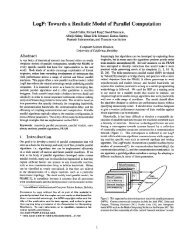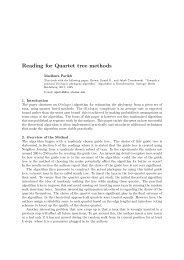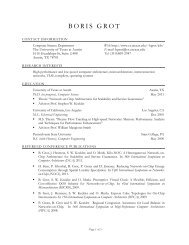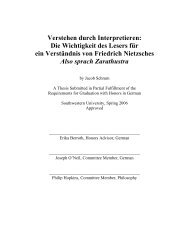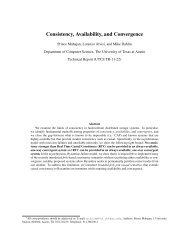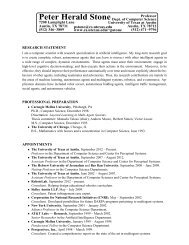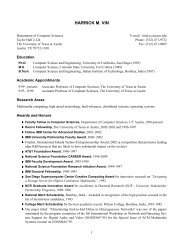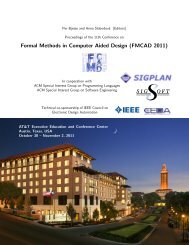A User's Guide to gringo, clasp, clingo, and iclingo
A User's Guide to gringo, clasp, clingo, and iclingo
A User's Guide to gringo, clasp, clingo, and iclingo
Create successful ePaper yourself
Turn your PDF publications into a flip-book with our unique Google optimized e-Paper software.
3.1.11 Optimization<br />
Optimization statements extend the basic question of whether a set of a<strong>to</strong>ms is an<br />
answer set <strong>to</strong> whether it is an optimal answer set. To support this reasoning mode,<br />
<strong>gringo</strong> <strong>and</strong> <strong>clingo</strong> adopt the optimization statements of lparse [53], indicated<br />
via keywords #maximize <strong>and</strong> #minimize. As an optimization statement does not<br />
admit a body, any (local) variable in it must also occur in an a<strong>to</strong>m (over a domain or<br />
built-in predicate) on the right-h<strong>and</strong> side of a condition (cf. Section 3.1.8) within the<br />
optimization statement. In multiset notation (square brackets), weights may be provided<br />
as with #sum aggregates. In set notation (curly brackets), duplicates of literals<br />
are removed as with count aggregates. Additionally, priorities can be associated with<br />
each literal. A (ground) optimize statement has the form:<br />
opt [ L1 = w1@p1, . . . , Ln = wn@pn }<br />
opt { L1@p1, . . . , Ln@pn }<br />
where opt is either #maximize or #minimize , Li are literals with associates (integer)<br />
weights wi <strong>and</strong> (integer) priorities pi.<br />
The semantics of an optimization statement is intuitive: an answer set is optimal<br />
if the sum of weights (using 1 for unsupplied weights) of literals that hold is maximal<br />
or minimal, as required by the statement, among all answer sets of the given program.<br />
This definition is sufficient if a single optimization statement is specified along with a<br />
logic program. If different priorities occur in the program, then, depending on the type<br />
of optimize statement, answer sets whose sum of weights assigned <strong>to</strong> higher priorities<br />
is maximized or minimized, respectively.<br />
Note that for compatibility with lparse, if multiple optimize statements are used,<br />
default priorities are assigned. The n-th statement gets priority n, thus, the later statements<br />
have higher priorities. We suggest that if you want <strong>to</strong> use more than one optimization<br />
statement, <strong>to</strong> always specify priorities <strong>to</strong> make the program more readable<br />
<strong>and</strong> order independent.<br />
Example 3.11. To illustrate optimization, we consider a hotel booking situation where<br />
we want <strong>to</strong> choose one among five available hotels. The hotels are identified via numbers<br />
assigned in descending order of stars. Of course, the more stars a hotel has, the<br />
more it costs per night. As an ancillary information, we know that hotel 4 is located<br />
on a main street, which is why we expect its rooms <strong>to</strong> be noisy. This knowledge is<br />
specified in Line 1–5 of the following program:<br />
1 1 { hotel(1..5) } 1.<br />
2 star(1,5). star(2,4). star(3,3). star(4,3). star(5,2).<br />
3 cost(1,170). cost(2,140). cost(3,90). cost(4,75). cost(5,60).<br />
4 main_street(4).<br />
5 noisy :- hotel(X), main_street(X).<br />
6 #maximize [ hotel(X) : star(X,Y) = Y @ 1 ].<br />
7 #minimize [ hotel(X) : cost(X,Y) : star(X,Z) = Y/Z @ 2 ].<br />
8 #minimize { noisy @ 3 }.<br />
Line 6–8 contribute optimization statements in inverse order of significance, according<br />
<strong>to</strong> which we want <strong>to</strong> choose the best hotel <strong>to</strong> book. The most significant optimization<br />
statement in Line 8 states that avoiding noise is our main priority. The secondary<br />
optimization criterion in Line 7 consists of minimizing the cost per star. Finally, the<br />
third optimization statement in Line 6 specifies that we want <strong>to</strong> maximize the number<br />
22



